Cultural and Social Diversity in Health Care
VerifiedAdded on 2023/06/07
|13
|3176
|102
AI Summary
The paper defines the social and cultural determinants of health and health care among the Aboriginal and Torres Strait Islanders and refugees in Australia. It discusses the key social determinants of health among the refugees and the indigenous Australians, health-related risk factors, health issues, strategies in place to address the risk factors, and possible strategies to address the deficit. The similarities and differences between the two groups are also highlighted.
Contribute Materials
Your contribution can guide someone’s learning journey. Share your
documents today.
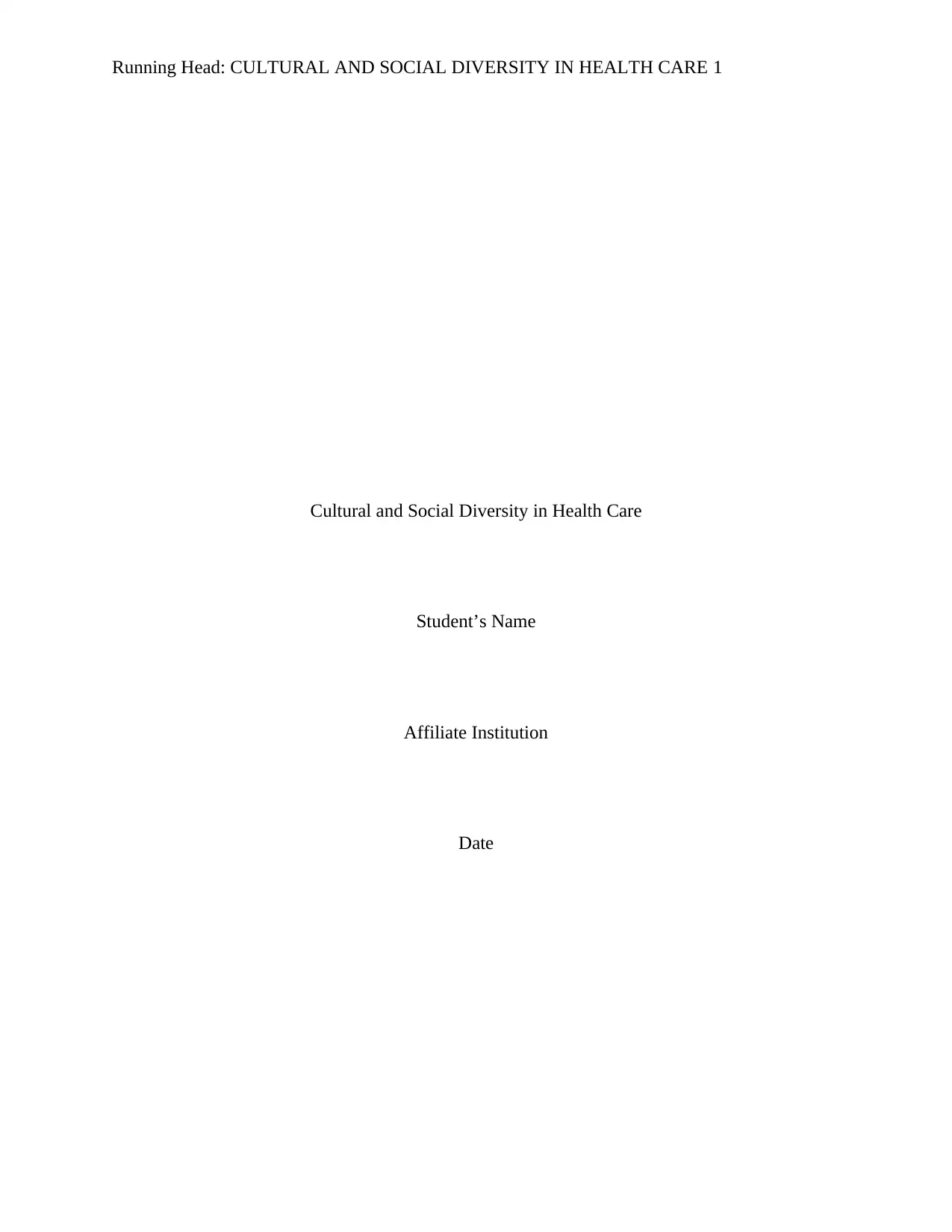
Running Head: CULTURAL AND SOCIAL DIVERSITY IN HEALTH CARE 1
Cultural and Social Diversity in Health Care
Student’s Name
Affiliate Institution
Date
Cultural and Social Diversity in Health Care
Student’s Name
Affiliate Institution
Date
Secure Best Marks with AI Grader
Need help grading? Try our AI Grader for instant feedback on your assignments.
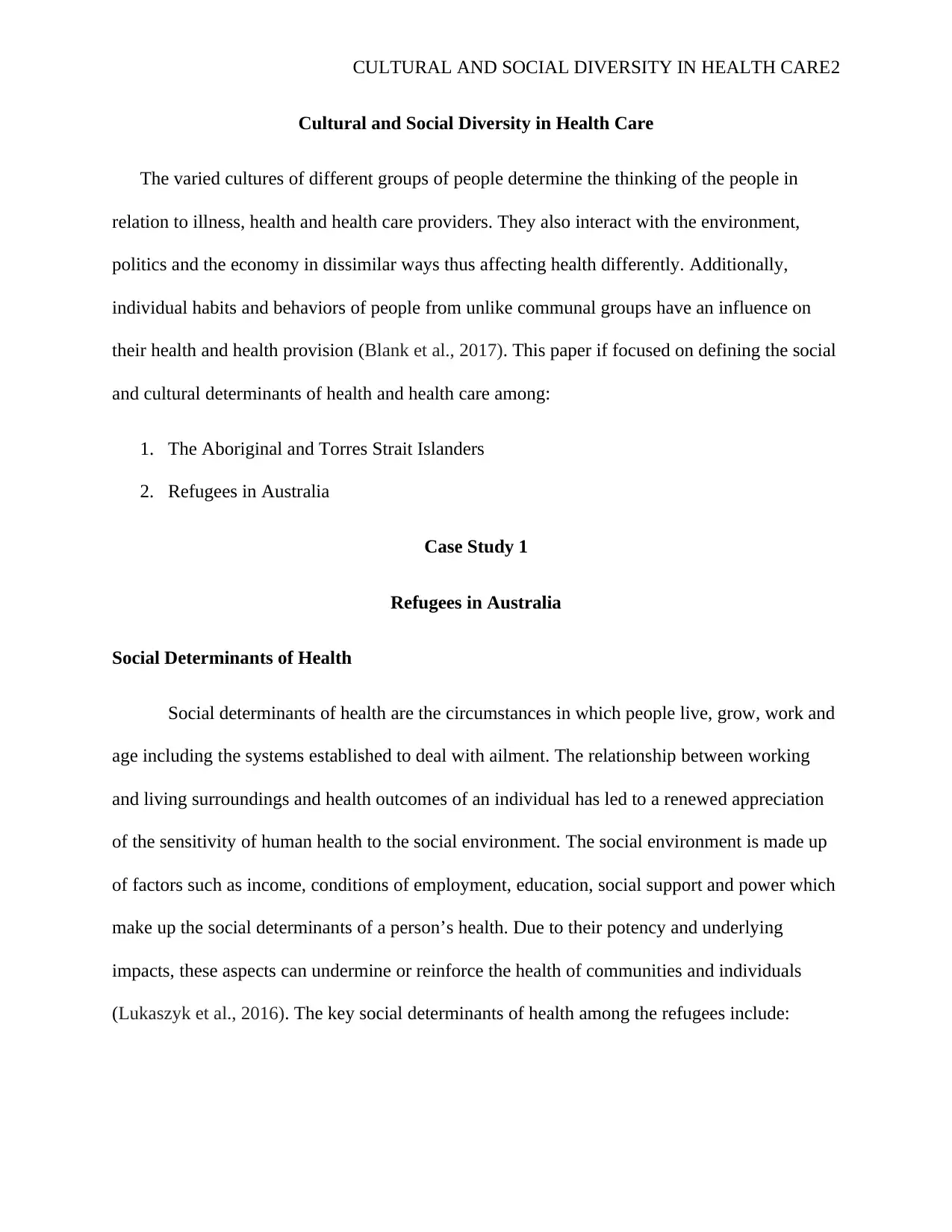
CULTURAL AND SOCIAL DIVERSITY IN HEALTH CARE2
Cultural and Social Diversity in Health Care
The varied cultures of different groups of people determine the thinking of the people in
relation to illness, health and health care providers. They also interact with the environment,
politics and the economy in dissimilar ways thus affecting health differently. Additionally,
individual habits and behaviors of people from unlike communal groups have an influence on
their health and health provision (Blank et al., 2017). This paper if focused on defining the social
and cultural determinants of health and health care among:
1. The Aboriginal and Torres Strait Islanders
2. Refugees in Australia
Case Study 1
Refugees in Australia
Social Determinants of Health
Social determinants of health are the circumstances in which people live, grow, work and
age including the systems established to deal with ailment. The relationship between working
and living surroundings and health outcomes of an individual has led to a renewed appreciation
of the sensitivity of human health to the social environment. The social environment is made up
of factors such as income, conditions of employment, education, social support and power which
make up the social determinants of a person’s health. Due to their potency and underlying
impacts, these aspects can undermine or reinforce the health of communities and individuals
(Lukaszyk et al., 2016). The key social determinants of health among the refugees include:
Cultural and Social Diversity in Health Care
The varied cultures of different groups of people determine the thinking of the people in
relation to illness, health and health care providers. They also interact with the environment,
politics and the economy in dissimilar ways thus affecting health differently. Additionally,
individual habits and behaviors of people from unlike communal groups have an influence on
their health and health provision (Blank et al., 2017). This paper if focused on defining the social
and cultural determinants of health and health care among:
1. The Aboriginal and Torres Strait Islanders
2. Refugees in Australia
Case Study 1
Refugees in Australia
Social Determinants of Health
Social determinants of health are the circumstances in which people live, grow, work and
age including the systems established to deal with ailment. The relationship between working
and living surroundings and health outcomes of an individual has led to a renewed appreciation
of the sensitivity of human health to the social environment. The social environment is made up
of factors such as income, conditions of employment, education, social support and power which
make up the social determinants of a person’s health. Due to their potency and underlying
impacts, these aspects can undermine or reinforce the health of communities and individuals
(Lukaszyk et al., 2016). The key social determinants of health among the refugees include:
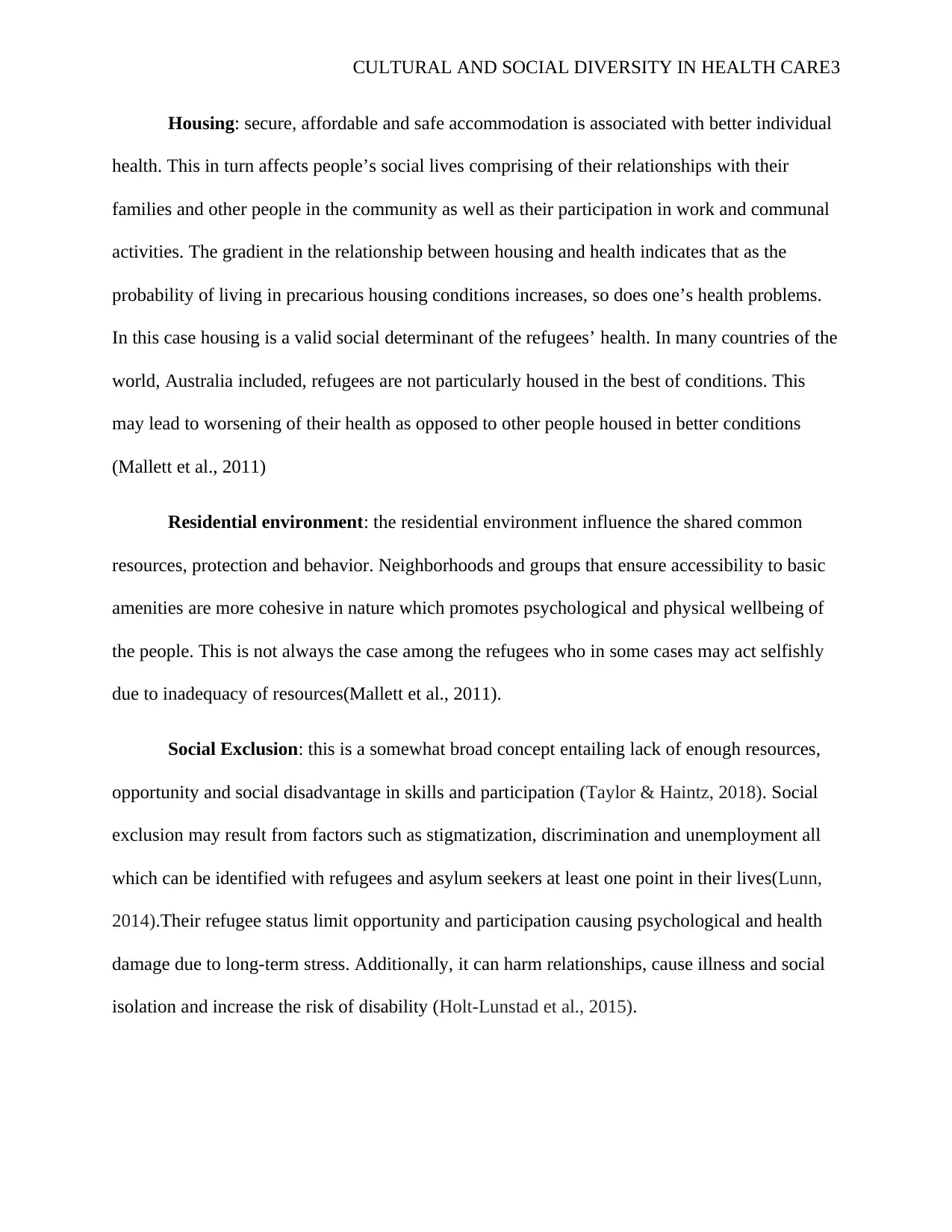
CULTURAL AND SOCIAL DIVERSITY IN HEALTH CARE3
Housing: secure, affordable and safe accommodation is associated with better individual
health. This in turn affects people’s social lives comprising of their relationships with their
families and other people in the community as well as their participation in work and communal
activities. The gradient in the relationship between housing and health indicates that as the
probability of living in precarious housing conditions increases, so does one’s health problems.
In this case housing is a valid social determinant of the refugees’ health. In many countries of the
world, Australia included, refugees are not particularly housed in the best of conditions. This
may lead to worsening of their health as opposed to other people housed in better conditions
(Mallett et al., 2011)
Residential environment: the residential environment influence the shared common
resources, protection and behavior. Neighborhoods and groups that ensure accessibility to basic
amenities are more cohesive in nature which promotes psychological and physical wellbeing of
the people. This is not always the case among the refugees who in some cases may act selfishly
due to inadequacy of resources(Mallett et al., 2011).
Social Exclusion: this is a somewhat broad concept entailing lack of enough resources,
opportunity and social disadvantage in skills and participation (Taylor & Haintz, 2018). Social
exclusion may result from factors such as stigmatization, discrimination and unemployment all
which can be identified with refugees and asylum seekers at least one point in their lives(Lunn,
2014).Their refugee status limit opportunity and participation causing psychological and health
damage due to long-term stress. Additionally, it can harm relationships, cause illness and social
isolation and increase the risk of disability (Holt-Lunstad et al., 2015).
Housing: secure, affordable and safe accommodation is associated with better individual
health. This in turn affects people’s social lives comprising of their relationships with their
families and other people in the community as well as their participation in work and communal
activities. The gradient in the relationship between housing and health indicates that as the
probability of living in precarious housing conditions increases, so does one’s health problems.
In this case housing is a valid social determinant of the refugees’ health. In many countries of the
world, Australia included, refugees are not particularly housed in the best of conditions. This
may lead to worsening of their health as opposed to other people housed in better conditions
(Mallett et al., 2011)
Residential environment: the residential environment influence the shared common
resources, protection and behavior. Neighborhoods and groups that ensure accessibility to basic
amenities are more cohesive in nature which promotes psychological and physical wellbeing of
the people. This is not always the case among the refugees who in some cases may act selfishly
due to inadequacy of resources(Mallett et al., 2011).
Social Exclusion: this is a somewhat broad concept entailing lack of enough resources,
opportunity and social disadvantage in skills and participation (Taylor & Haintz, 2018). Social
exclusion may result from factors such as stigmatization, discrimination and unemployment all
which can be identified with refugees and asylum seekers at least one point in their lives(Lunn,
2014).Their refugee status limit opportunity and participation causing psychological and health
damage due to long-term stress. Additionally, it can harm relationships, cause illness and social
isolation and increase the risk of disability (Holt-Lunstad et al., 2015).
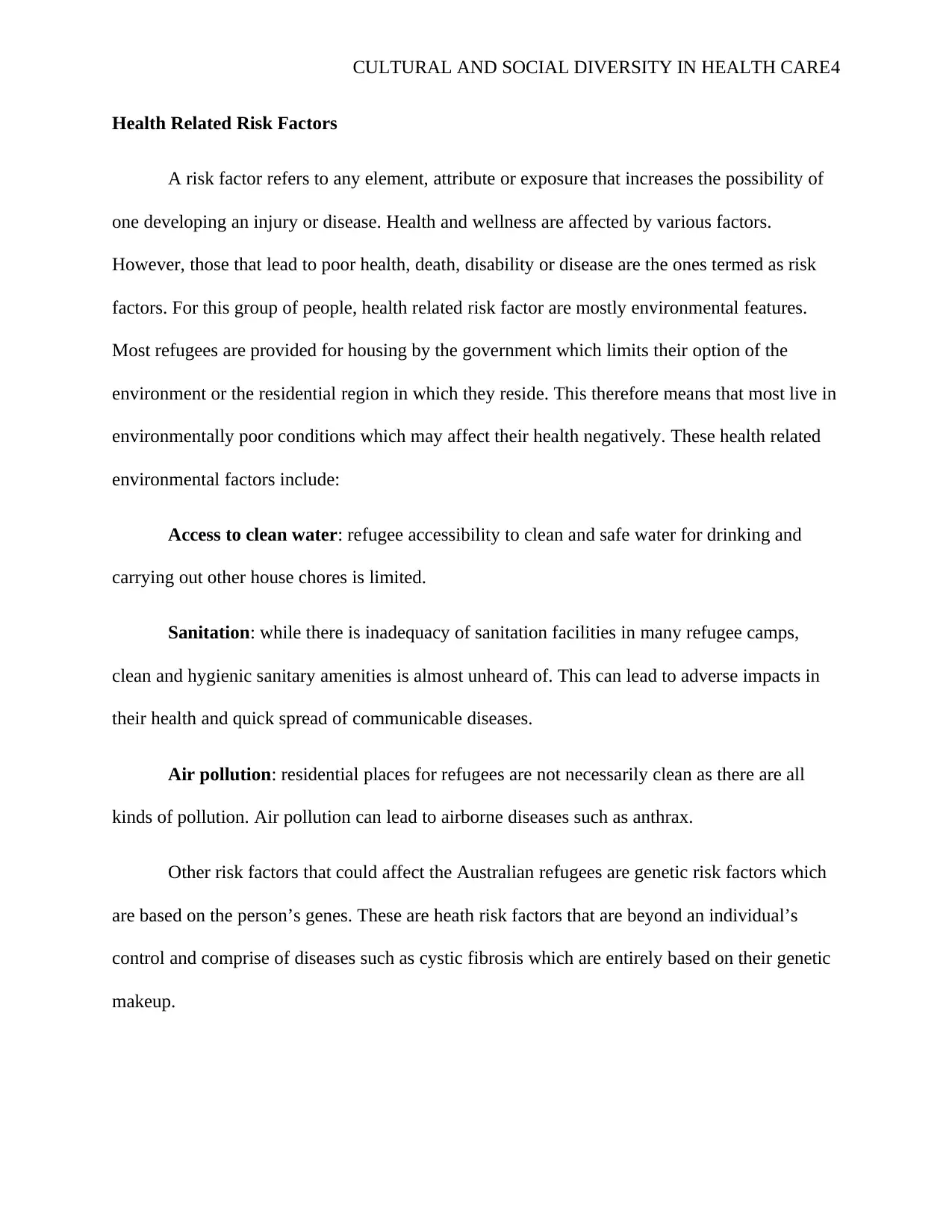
CULTURAL AND SOCIAL DIVERSITY IN HEALTH CARE4
Health Related Risk Factors
A risk factor refers to any element, attribute or exposure that increases the possibility of
one developing an injury or disease. Health and wellness are affected by various factors.
However, those that lead to poor health, death, disability or disease are the ones termed as risk
factors. For this group of people, health related risk factor are mostly environmental features.
Most refugees are provided for housing by the government which limits their option of the
environment or the residential region in which they reside. This therefore means that most live in
environmentally poor conditions which may affect their health negatively. These health related
environmental factors include:
Access to clean water: refugee accessibility to clean and safe water for drinking and
carrying out other house chores is limited.
Sanitation: while there is inadequacy of sanitation facilities in many refugee camps,
clean and hygienic sanitary amenities is almost unheard of. This can lead to adverse impacts in
their health and quick spread of communicable diseases.
Air pollution: residential places for refugees are not necessarily clean as there are all
kinds of pollution. Air pollution can lead to airborne diseases such as anthrax.
Other risk factors that could affect the Australian refugees are genetic risk factors which
are based on the person’s genes. These are heath risk factors that are beyond an individual’s
control and comprise of diseases such as cystic fibrosis which are entirely based on their genetic
makeup.
Health Related Risk Factors
A risk factor refers to any element, attribute or exposure that increases the possibility of
one developing an injury or disease. Health and wellness are affected by various factors.
However, those that lead to poor health, death, disability or disease are the ones termed as risk
factors. For this group of people, health related risk factor are mostly environmental features.
Most refugees are provided for housing by the government which limits their option of the
environment or the residential region in which they reside. This therefore means that most live in
environmentally poor conditions which may affect their health negatively. These health related
environmental factors include:
Access to clean water: refugee accessibility to clean and safe water for drinking and
carrying out other house chores is limited.
Sanitation: while there is inadequacy of sanitation facilities in many refugee camps,
clean and hygienic sanitary amenities is almost unheard of. This can lead to adverse impacts in
their health and quick spread of communicable diseases.
Air pollution: residential places for refugees are not necessarily clean as there are all
kinds of pollution. Air pollution can lead to airborne diseases such as anthrax.
Other risk factors that could affect the Australian refugees are genetic risk factors which
are based on the person’s genes. These are heath risk factors that are beyond an individual’s
control and comprise of diseases such as cystic fibrosis which are entirely based on their genetic
makeup.
Secure Best Marks with AI Grader
Need help grading? Try our AI Grader for instant feedback on your assignments.
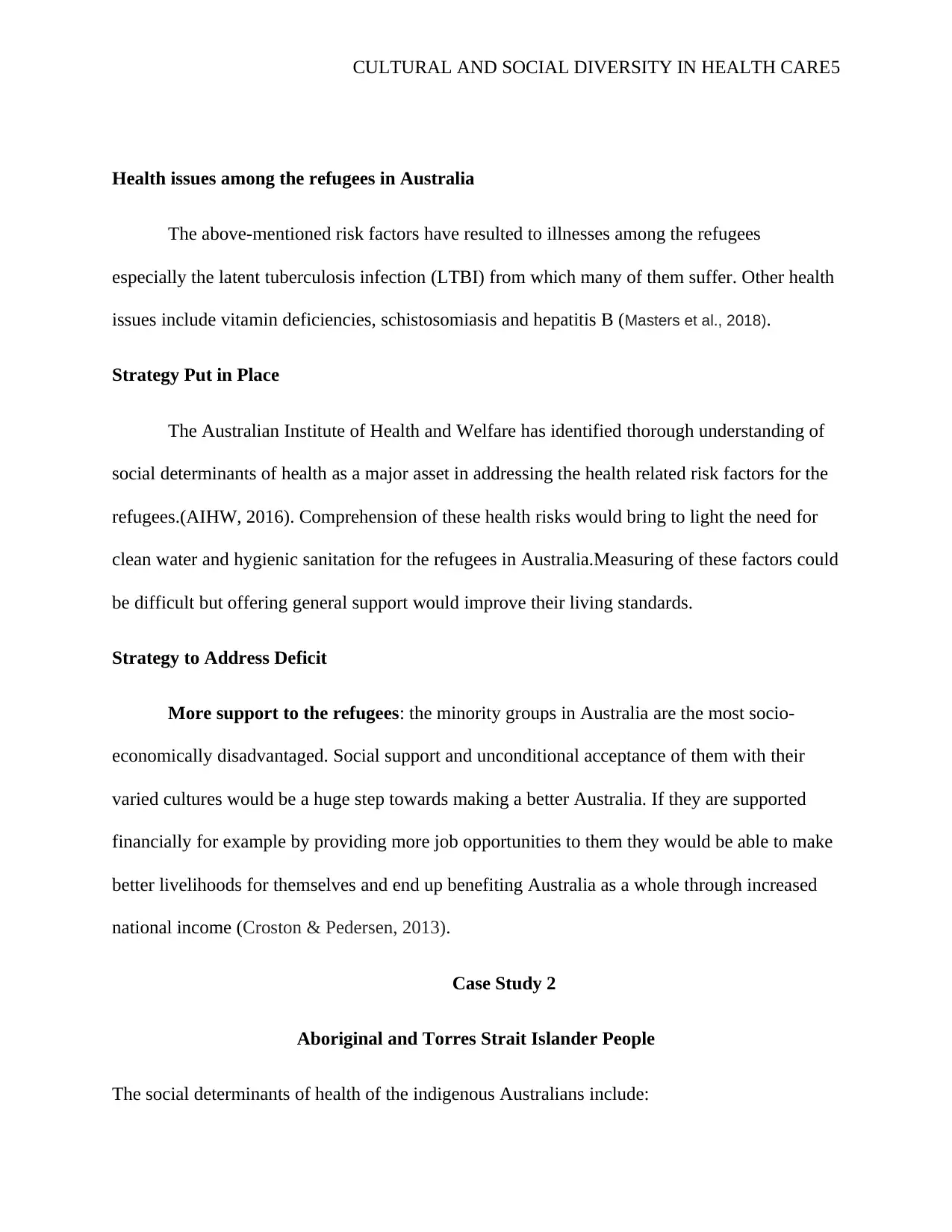
CULTURAL AND SOCIAL DIVERSITY IN HEALTH CARE5
Health issues among the refugees in Australia
The above-mentioned risk factors have resulted to illnesses among the refugees
especially the latent tuberculosis infection (LTBI) from which many of them suffer. Other health
issues include vitamin deficiencies, schistosomiasis and hepatitis B (Masters et al., 2018).
Strategy Put in Place
The Australian Institute of Health and Welfare has identified thorough understanding of
social determinants of health as a major asset in addressing the health related risk factors for the
refugees.(AIHW, 2016). Comprehension of these health risks would bring to light the need for
clean water and hygienic sanitation for the refugees in Australia.Measuring of these factors could
be difficult but offering general support would improve their living standards.
Strategy to Address Deficit
More support to the refugees: the minority groups in Australia are the most socio-
economically disadvantaged. Social support and unconditional acceptance of them with their
varied cultures would be a huge step towards making a better Australia. If they are supported
financially for example by providing more job opportunities to them they would be able to make
better livelihoods for themselves and end up benefiting Australia as a whole through increased
national income (Croston & Pedersen, 2013).
Case Study 2
Aboriginal and Torres Strait Islander People
The social determinants of health of the indigenous Australians include:
Health issues among the refugees in Australia
The above-mentioned risk factors have resulted to illnesses among the refugees
especially the latent tuberculosis infection (LTBI) from which many of them suffer. Other health
issues include vitamin deficiencies, schistosomiasis and hepatitis B (Masters et al., 2018).
Strategy Put in Place
The Australian Institute of Health and Welfare has identified thorough understanding of
social determinants of health as a major asset in addressing the health related risk factors for the
refugees.(AIHW, 2016). Comprehension of these health risks would bring to light the need for
clean water and hygienic sanitation for the refugees in Australia.Measuring of these factors could
be difficult but offering general support would improve their living standards.
Strategy to Address Deficit
More support to the refugees: the minority groups in Australia are the most socio-
economically disadvantaged. Social support and unconditional acceptance of them with their
varied cultures would be a huge step towards making a better Australia. If they are supported
financially for example by providing more job opportunities to them they would be able to make
better livelihoods for themselves and end up benefiting Australia as a whole through increased
national income (Croston & Pedersen, 2013).
Case Study 2
Aboriginal and Torres Strait Islander People
The social determinants of health of the indigenous Australians include:
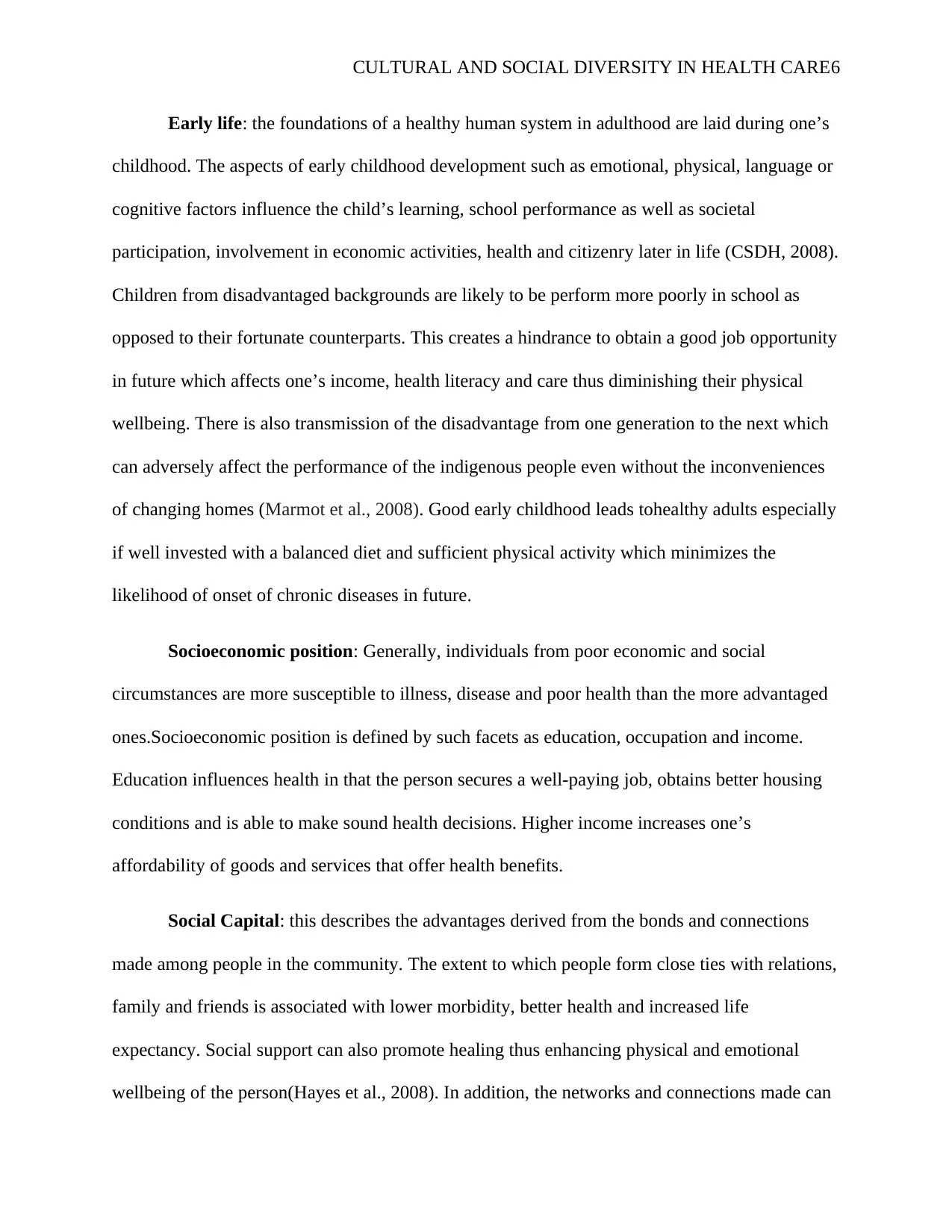
CULTURAL AND SOCIAL DIVERSITY IN HEALTH CARE6
Early life: the foundations of a healthy human system in adulthood are laid during one’s
childhood. The aspects of early childhood development such as emotional, physical, language or
cognitive factors influence the child’s learning, school performance as well as societal
participation, involvement in economic activities, health and citizenry later in life (CSDH, 2008).
Children from disadvantaged backgrounds are likely to be perform more poorly in school as
opposed to their fortunate counterparts. This creates a hindrance to obtain a good job opportunity
in future which affects one’s income, health literacy and care thus diminishing their physical
wellbeing. There is also transmission of the disadvantage from one generation to the next which
can adversely affect the performance of the indigenous people even without the inconveniences
of changing homes (Marmot et al., 2008). Good early childhood leads tohealthy adults especially
if well invested with a balanced diet and sufficient physical activity which minimizes the
likelihood of onset of chronic diseases in future.
Socioeconomic position: Generally, individuals from poor economic and social
circumstances are more susceptible to illness, disease and poor health than the more advantaged
ones.Socioeconomic position is defined by such facets as education, occupation and income.
Education influences health in that the person secures a well-paying job, obtains better housing
conditions and is able to make sound health decisions. Higher income increases one’s
affordability of goods and services that offer health benefits.
Social Capital: this describes the advantages derived from the bonds and connections
made among people in the community. The extent to which people form close ties with relations,
family and friends is associated with lower morbidity, better health and increased life
expectancy. Social support can also promote healing thus enhancing physical and emotional
wellbeing of the person(Hayes et al., 2008). In addition, the networks and connections made can
Early life: the foundations of a healthy human system in adulthood are laid during one’s
childhood. The aspects of early childhood development such as emotional, physical, language or
cognitive factors influence the child’s learning, school performance as well as societal
participation, involvement in economic activities, health and citizenry later in life (CSDH, 2008).
Children from disadvantaged backgrounds are likely to be perform more poorly in school as
opposed to their fortunate counterparts. This creates a hindrance to obtain a good job opportunity
in future which affects one’s income, health literacy and care thus diminishing their physical
wellbeing. There is also transmission of the disadvantage from one generation to the next which
can adversely affect the performance of the indigenous people even without the inconveniences
of changing homes (Marmot et al., 2008). Good early childhood leads tohealthy adults especially
if well invested with a balanced diet and sufficient physical activity which minimizes the
likelihood of onset of chronic diseases in future.
Socioeconomic position: Generally, individuals from poor economic and social
circumstances are more susceptible to illness, disease and poor health than the more advantaged
ones.Socioeconomic position is defined by such facets as education, occupation and income.
Education influences health in that the person secures a well-paying job, obtains better housing
conditions and is able to make sound health decisions. Higher income increases one’s
affordability of goods and services that offer health benefits.
Social Capital: this describes the advantages derived from the bonds and connections
made among people in the community. The extent to which people form close ties with relations,
family and friends is associated with lower morbidity, better health and increased life
expectancy. Social support can also promote healing thus enhancing physical and emotional
wellbeing of the person(Hayes et al., 2008). In addition, the networks and connections made can
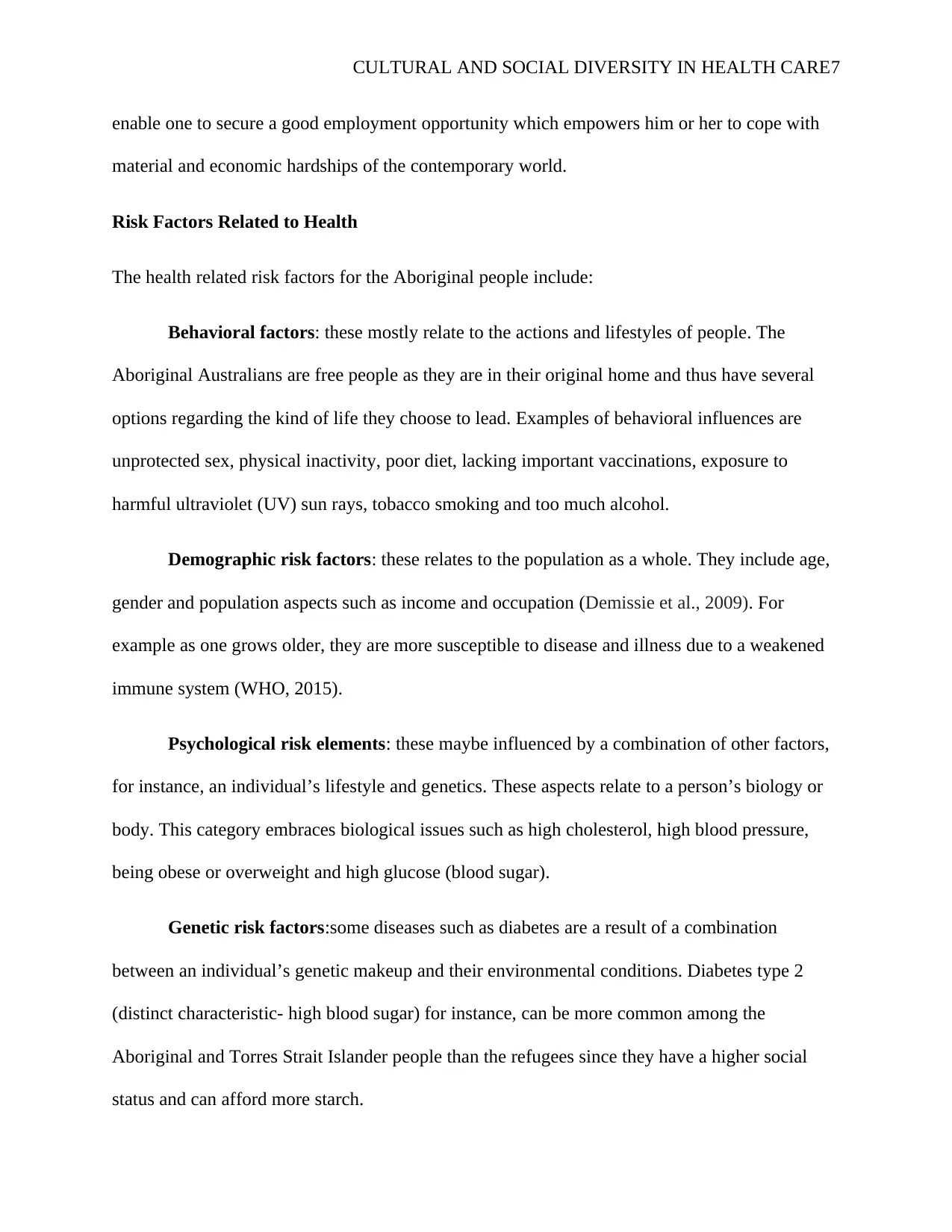
CULTURAL AND SOCIAL DIVERSITY IN HEALTH CARE7
enable one to secure a good employment opportunity which empowers him or her to cope with
material and economic hardships of the contemporary world.
Risk Factors Related to Health
The health related risk factors for the Aboriginal people include:
Behavioral factors: these mostly relate to the actions and lifestyles of people. The
Aboriginal Australians are free people as they are in their original home and thus have several
options regarding the kind of life they choose to lead. Examples of behavioral influences are
unprotected sex, physical inactivity, poor diet, lacking important vaccinations, exposure to
harmful ultraviolet (UV) sun rays, tobacco smoking and too much alcohol.
Demographic risk factors: these relates to the population as a whole. They include age,
gender and population aspects such as income and occupation (Demissie et al., 2009). For
example as one grows older, they are more susceptible to disease and illness due to a weakened
immune system (WHO, 2015).
Psychological risk elements: these maybe influenced by a combination of other factors,
for instance, an individual’s lifestyle and genetics. These aspects relate to a person’s biology or
body. This category embraces biological issues such as high cholesterol, high blood pressure,
being obese or overweight and high glucose (blood sugar).
Genetic risk factors:some diseases such as diabetes are a result of a combination
between an individual’s genetic makeup and their environmental conditions. Diabetes type 2
(distinct characteristic- high blood sugar) for instance, can be more common among the
Aboriginal and Torres Strait Islander people than the refugees since they have a higher social
status and can afford more starch.
enable one to secure a good employment opportunity which empowers him or her to cope with
material and economic hardships of the contemporary world.
Risk Factors Related to Health
The health related risk factors for the Aboriginal people include:
Behavioral factors: these mostly relate to the actions and lifestyles of people. The
Aboriginal Australians are free people as they are in their original home and thus have several
options regarding the kind of life they choose to lead. Examples of behavioral influences are
unprotected sex, physical inactivity, poor diet, lacking important vaccinations, exposure to
harmful ultraviolet (UV) sun rays, tobacco smoking and too much alcohol.
Demographic risk factors: these relates to the population as a whole. They include age,
gender and population aspects such as income and occupation (Demissie et al., 2009). For
example as one grows older, they are more susceptible to disease and illness due to a weakened
immune system (WHO, 2015).
Psychological risk elements: these maybe influenced by a combination of other factors,
for instance, an individual’s lifestyle and genetics. These aspects relate to a person’s biology or
body. This category embraces biological issues such as high cholesterol, high blood pressure,
being obese or overweight and high glucose (blood sugar).
Genetic risk factors:some diseases such as diabetes are a result of a combination
between an individual’s genetic makeup and their environmental conditions. Diabetes type 2
(distinct characteristic- high blood sugar) for instance, can be more common among the
Aboriginal and Torres Strait Islander people than the refugees since they have a higher social
status and can afford more starch.
Paraphrase This Document
Need a fresh take? Get an instant paraphrase of this document with our AI Paraphraser
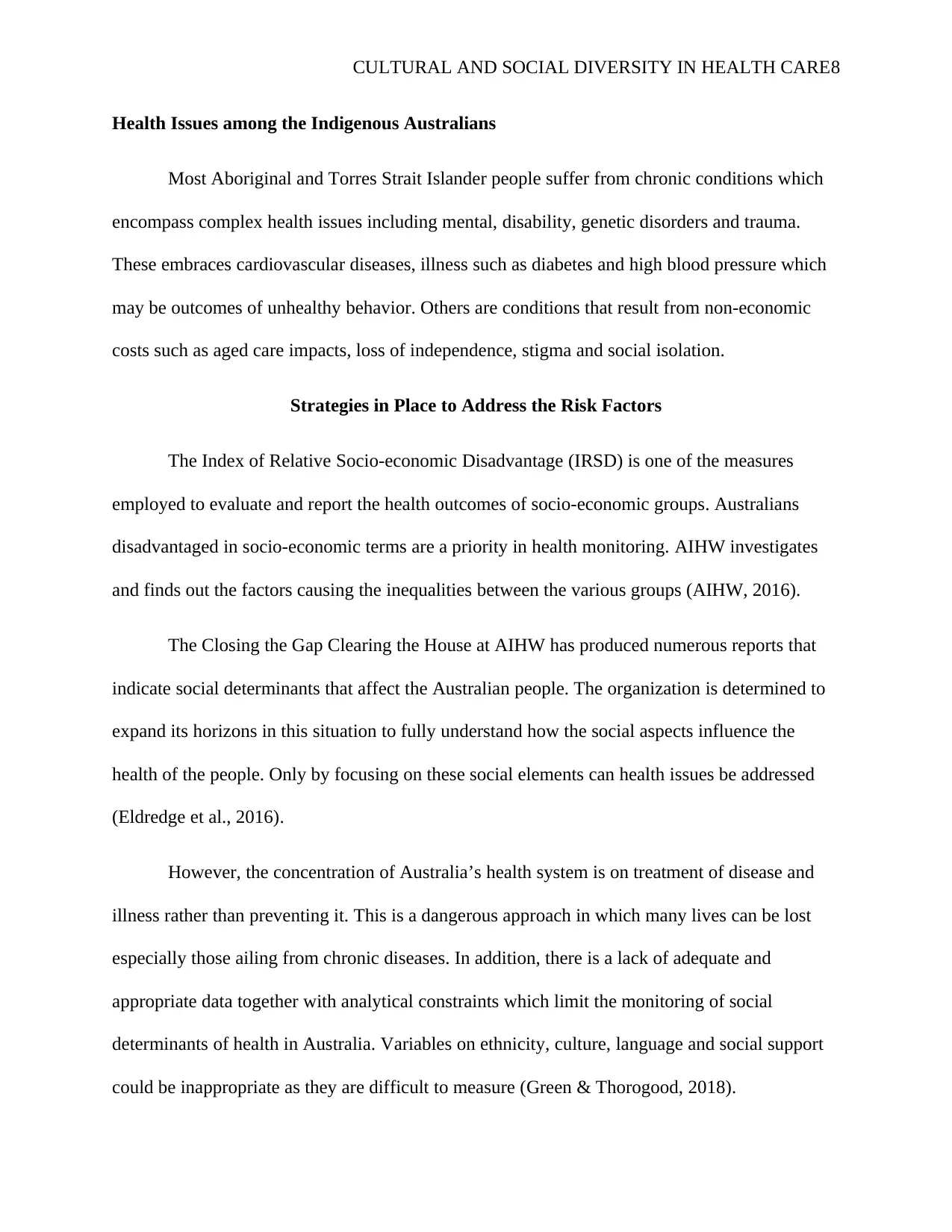
CULTURAL AND SOCIAL DIVERSITY IN HEALTH CARE8
Health Issues among the Indigenous Australians
Most Aboriginal and Torres Strait Islander people suffer from chronic conditions which
encompass complex health issues including mental, disability, genetic disorders and trauma.
These embraces cardiovascular diseases, illness such as diabetes and high blood pressure which
may be outcomes of unhealthy behavior. Others are conditions that result from non-economic
costs such as aged care impacts, loss of independence, stigma and social isolation.
Strategies in Place to Address the Risk Factors
The Index of Relative Socio-economic Disadvantage (IRSD) is one of the measures
employed to evaluate and report the health outcomes of socio-economic groups. Australians
disadvantaged in socio-economic terms are a priority in health monitoring. AIHW investigates
and finds out the factors causing the inequalities between the various groups (AIHW, 2016).
The Closing the Gap Clearing the House at AIHW has produced numerous reports that
indicate social determinants that affect the Australian people. The organization is determined to
expand its horizons in this situation to fully understand how the social aspects influence the
health of the people. Only by focusing on these social elements can health issues be addressed
(Eldredge et al., 2016).
However, the concentration of Australia’s health system is on treatment of disease and
illness rather than preventing it. This is a dangerous approach in which many lives can be lost
especially those ailing from chronic diseases. In addition, there is a lack of adequate and
appropriate data together with analytical constraints which limit the monitoring of social
determinants of health in Australia. Variables on ethnicity, culture, language and social support
could be inappropriate as they are difficult to measure (Green & Thorogood, 2018).
Health Issues among the Indigenous Australians
Most Aboriginal and Torres Strait Islander people suffer from chronic conditions which
encompass complex health issues including mental, disability, genetic disorders and trauma.
These embraces cardiovascular diseases, illness such as diabetes and high blood pressure which
may be outcomes of unhealthy behavior. Others are conditions that result from non-economic
costs such as aged care impacts, loss of independence, stigma and social isolation.
Strategies in Place to Address the Risk Factors
The Index of Relative Socio-economic Disadvantage (IRSD) is one of the measures
employed to evaluate and report the health outcomes of socio-economic groups. Australians
disadvantaged in socio-economic terms are a priority in health monitoring. AIHW investigates
and finds out the factors causing the inequalities between the various groups (AIHW, 2016).
The Closing the Gap Clearing the House at AIHW has produced numerous reports that
indicate social determinants that affect the Australian people. The organization is determined to
expand its horizons in this situation to fully understand how the social aspects influence the
health of the people. Only by focusing on these social elements can health issues be addressed
(Eldredge et al., 2016).
However, the concentration of Australia’s health system is on treatment of disease and
illness rather than preventing it. This is a dangerous approach in which many lives can be lost
especially those ailing from chronic diseases. In addition, there is a lack of adequate and
appropriate data together with analytical constraints which limit the monitoring of social
determinants of health in Australia. Variables on ethnicity, culture, language and social support
could be inappropriate as they are difficult to measure (Green & Thorogood, 2018).
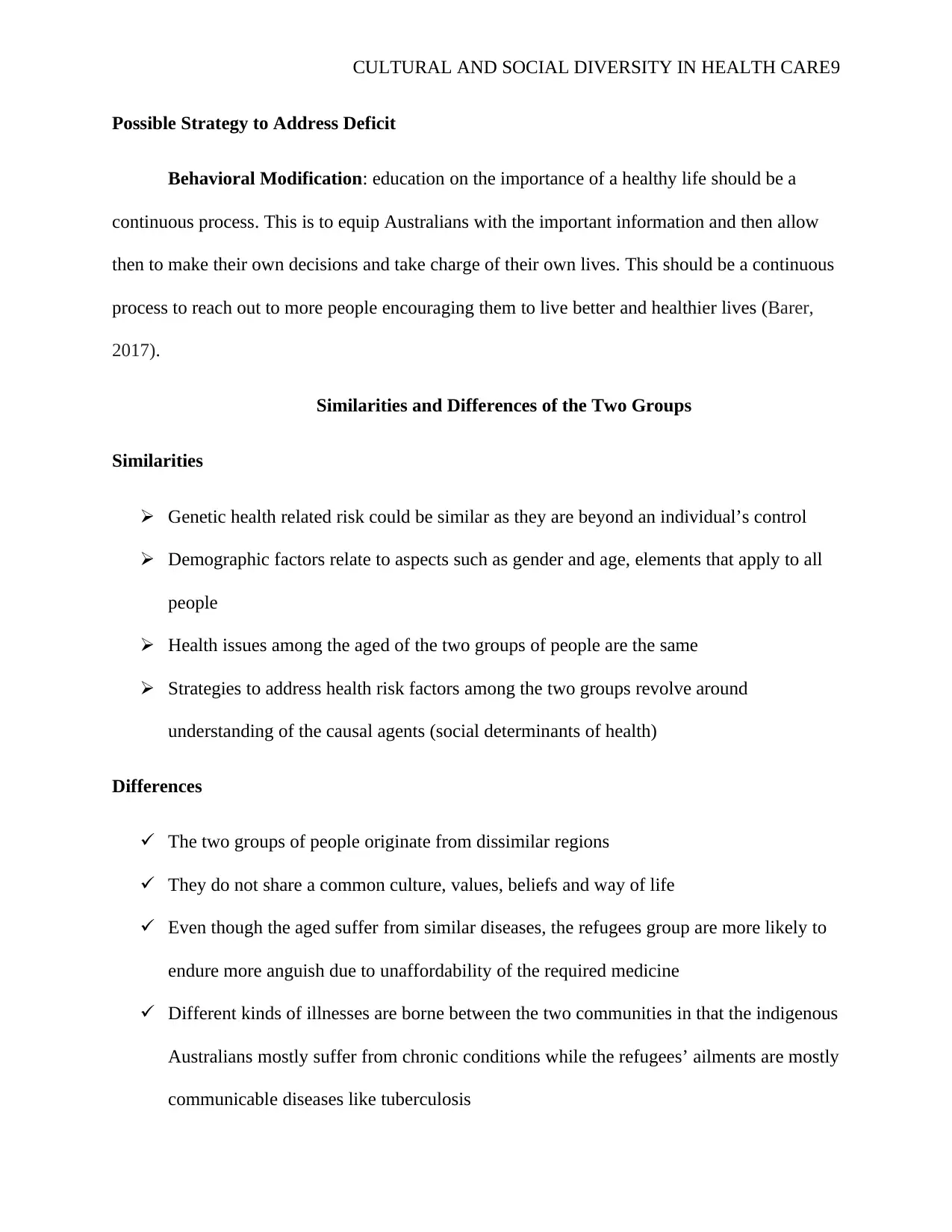
CULTURAL AND SOCIAL DIVERSITY IN HEALTH CARE9
Possible Strategy to Address Deficit
Behavioral Modification: education on the importance of a healthy life should be a
continuous process. This is to equip Australians with the important information and then allow
then to make their own decisions and take charge of their own lives. This should be a continuous
process to reach out to more people encouraging them to live better and healthier lives (Barer,
2017).
Similarities and Differences of the Two Groups
Similarities
Genetic health related risk could be similar as they are beyond an individual’s control
Demographic factors relate to aspects such as gender and age, elements that apply to all
people
Health issues among the aged of the two groups of people are the same
Strategies to address health risk factors among the two groups revolve around
understanding of the causal agents (social determinants of health)
Differences
The two groups of people originate from dissimilar regions
They do not share a common culture, values, beliefs and way of life
Even though the aged suffer from similar diseases, the refugees group are more likely to
endure more anguish due to unaffordability of the required medicine
Different kinds of illnesses are borne between the two communities in that the indigenous
Australians mostly suffer from chronic conditions while the refugees’ ailments are mostly
communicable diseases like tuberculosis
Possible Strategy to Address Deficit
Behavioral Modification: education on the importance of a healthy life should be a
continuous process. This is to equip Australians with the important information and then allow
then to make their own decisions and take charge of their own lives. This should be a continuous
process to reach out to more people encouraging them to live better and healthier lives (Barer,
2017).
Similarities and Differences of the Two Groups
Similarities
Genetic health related risk could be similar as they are beyond an individual’s control
Demographic factors relate to aspects such as gender and age, elements that apply to all
people
Health issues among the aged of the two groups of people are the same
Strategies to address health risk factors among the two groups revolve around
understanding of the causal agents (social determinants of health)
Differences
The two groups of people originate from dissimilar regions
They do not share a common culture, values, beliefs and way of life
Even though the aged suffer from similar diseases, the refugees group are more likely to
endure more anguish due to unaffordability of the required medicine
Different kinds of illnesses are borne between the two communities in that the indigenous
Australians mostly suffer from chronic conditions while the refugees’ ailments are mostly
communicable diseases like tuberculosis
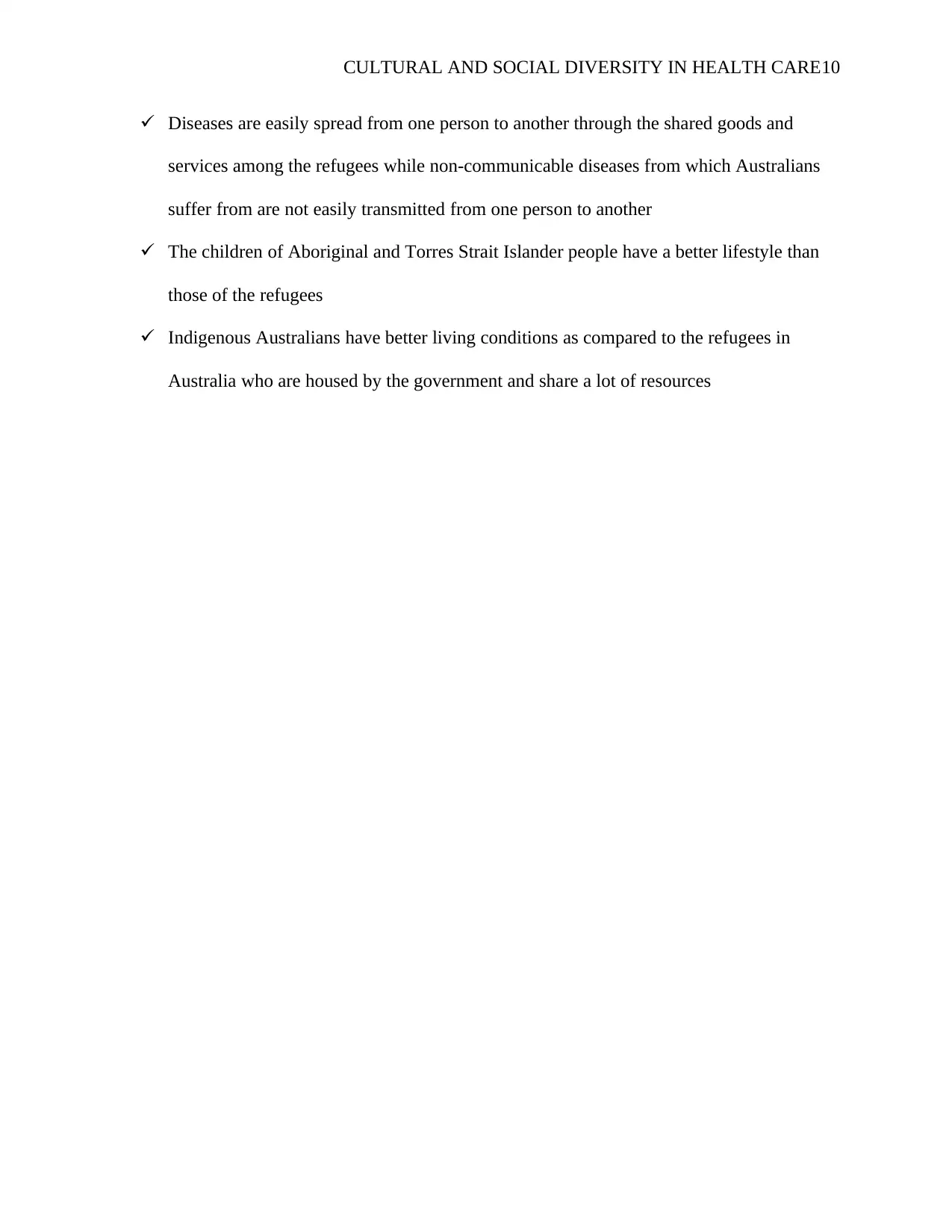
CULTURAL AND SOCIAL DIVERSITY IN HEALTH CARE10
Diseases are easily spread from one person to another through the shared goods and
services among the refugees while non-communicable diseases from which Australians
suffer from are not easily transmitted from one person to another
The children of Aboriginal and Torres Strait Islander people have a better lifestyle than
those of the refugees
Indigenous Australians have better living conditions as compared to the refugees in
Australia who are housed by the government and share a lot of resources
Diseases are easily spread from one person to another through the shared goods and
services among the refugees while non-communicable diseases from which Australians
suffer from are not easily transmitted from one person to another
The children of Aboriginal and Torres Strait Islander people have a better lifestyle than
those of the refugees
Indigenous Australians have better living conditions as compared to the refugees in
Australia who are housed by the government and share a lot of resources
Secure Best Marks with AI Grader
Need help grading? Try our AI Grader for instant feedback on your assignments.
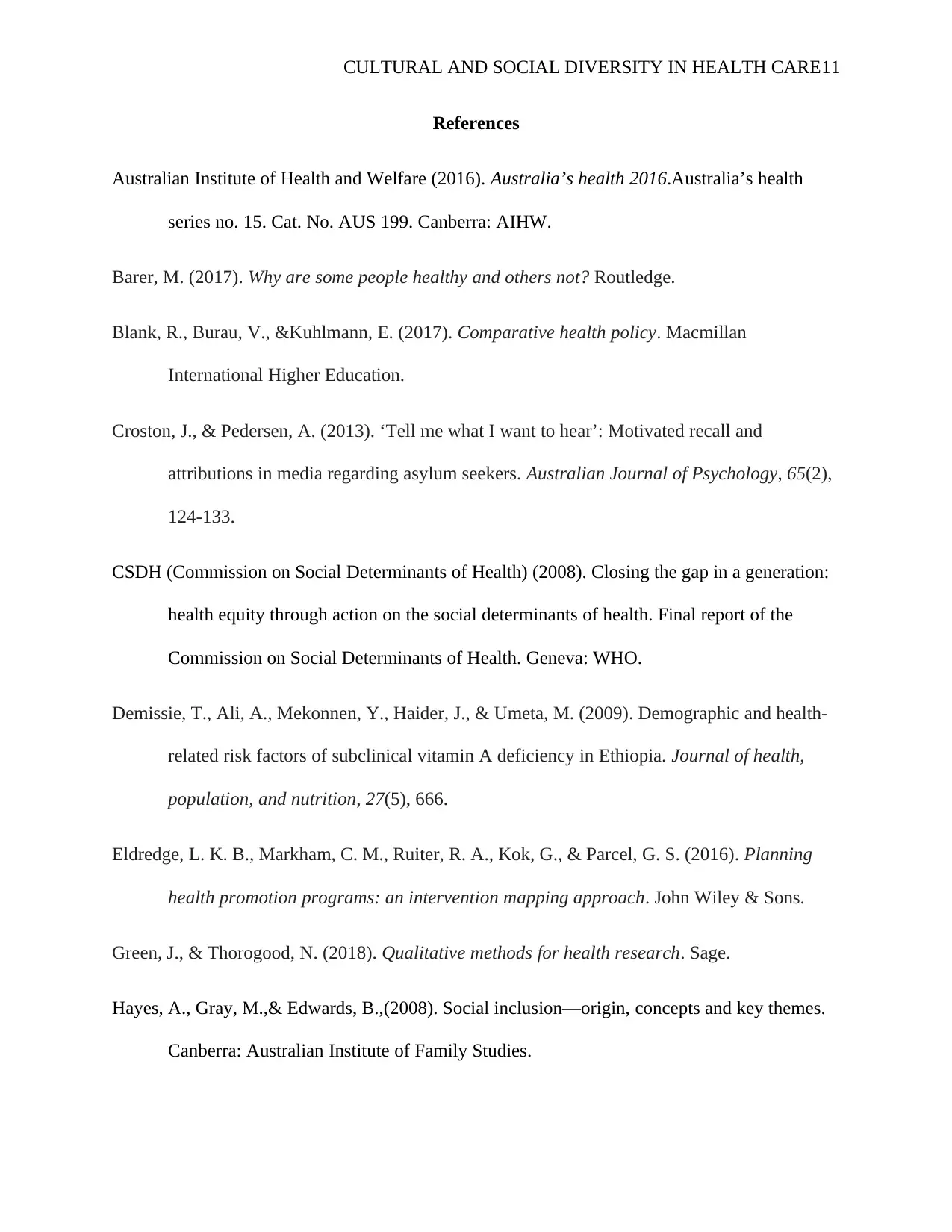
CULTURAL AND SOCIAL DIVERSITY IN HEALTH CARE11
References
Australian Institute of Health and Welfare (2016). Australia’s health 2016.Australia’s health
series no. 15. Cat. No. AUS 199. Canberra: AIHW.
Barer, M. (2017). Why are some people healthy and others not? Routledge.
Blank, R., Burau, V., &Kuhlmann, E. (2017). Comparative health policy. Macmillan
International Higher Education.
Croston, J., & Pedersen, A. (2013). ‘Tell me what I want to hear’: Motivated recall and
attributions in media regarding asylum seekers. Australian Journal of Psychology, 65(2),
124-133.
CSDH (Commission on Social Determinants of Health) (2008). Closing the gap in a generation:
health equity through action on the social determinants of health. Final report of the
Commission on Social Determinants of Health. Geneva: WHO.
Demissie, T., Ali, A., Mekonnen, Y., Haider, J., & Umeta, M. (2009). Demographic and health-
related risk factors of subclinical vitamin A deficiency in Ethiopia. Journal of health,
population, and nutrition, 27(5), 666.
Eldredge, L. K. B., Markham, C. M., Ruiter, R. A., Kok, G., & Parcel, G. S. (2016). Planning
health promotion programs: an intervention mapping approach. John Wiley & Sons.
Green, J., & Thorogood, N. (2018). Qualitative methods for health research. Sage.
Hayes, A., Gray, M.,& Edwards, B.,(2008). Social inclusion—origin, concepts and key themes.
Canberra: Australian Institute of Family Studies.
References
Australian Institute of Health and Welfare (2016). Australia’s health 2016.Australia’s health
series no. 15. Cat. No. AUS 199. Canberra: AIHW.
Barer, M. (2017). Why are some people healthy and others not? Routledge.
Blank, R., Burau, V., &Kuhlmann, E. (2017). Comparative health policy. Macmillan
International Higher Education.
Croston, J., & Pedersen, A. (2013). ‘Tell me what I want to hear’: Motivated recall and
attributions in media regarding asylum seekers. Australian Journal of Psychology, 65(2),
124-133.
CSDH (Commission on Social Determinants of Health) (2008). Closing the gap in a generation:
health equity through action on the social determinants of health. Final report of the
Commission on Social Determinants of Health. Geneva: WHO.
Demissie, T., Ali, A., Mekonnen, Y., Haider, J., & Umeta, M. (2009). Demographic and health-
related risk factors of subclinical vitamin A deficiency in Ethiopia. Journal of health,
population, and nutrition, 27(5), 666.
Eldredge, L. K. B., Markham, C. M., Ruiter, R. A., Kok, G., & Parcel, G. S. (2016). Planning
health promotion programs: an intervention mapping approach. John Wiley & Sons.
Green, J., & Thorogood, N. (2018). Qualitative methods for health research. Sage.
Hayes, A., Gray, M.,& Edwards, B.,(2008). Social inclusion—origin, concepts and key themes.
Canberra: Australian Institute of Family Studies.
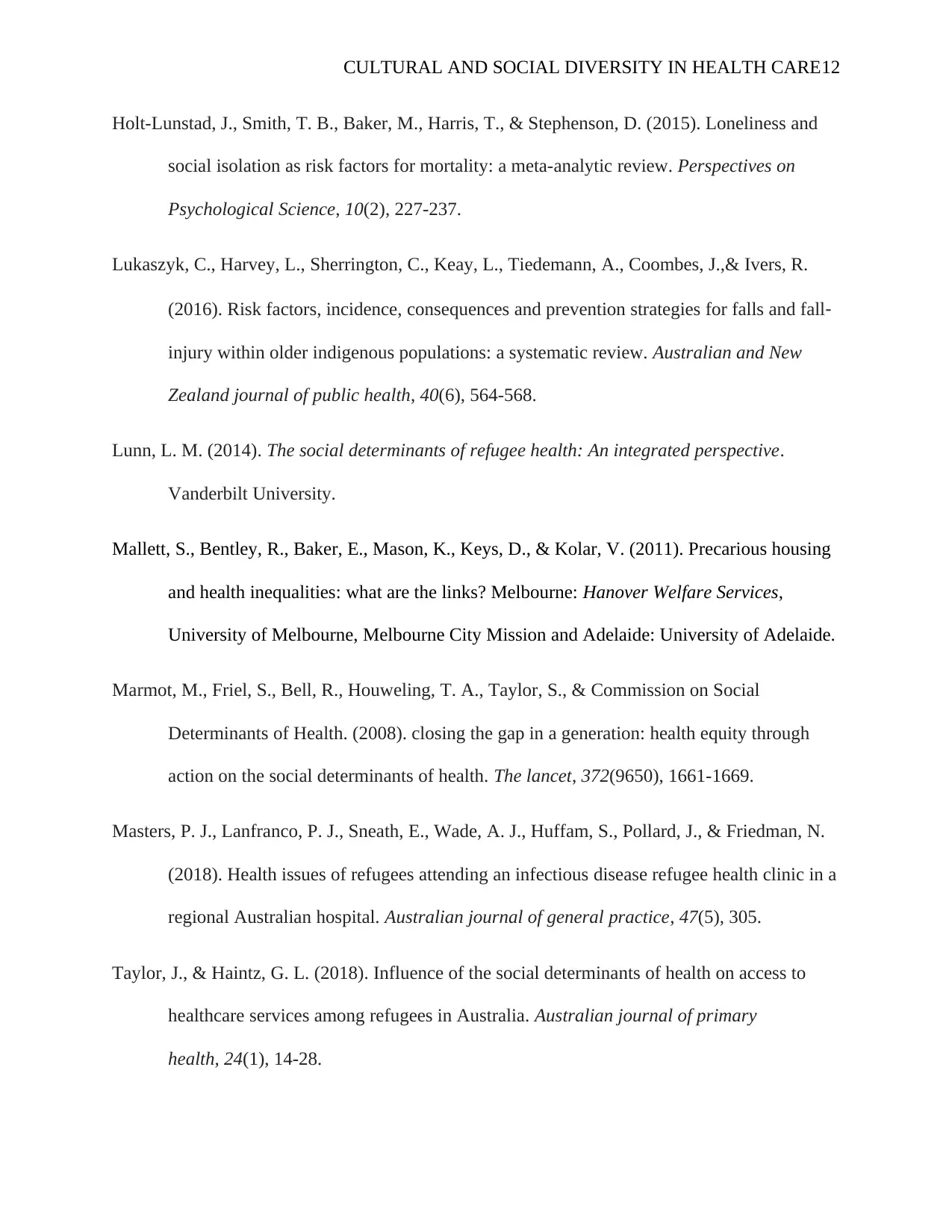
CULTURAL AND SOCIAL DIVERSITY IN HEALTH CARE12
Holt-Lunstad, J., Smith, T. B., Baker, M., Harris, T., & Stephenson, D. (2015). Loneliness and
social isolation as risk factors for mortality: a meta-analytic review. Perspectives on
Psychological Science, 10(2), 227-237.
Lukaszyk, C., Harvey, L., Sherrington, C., Keay, L., Tiedemann, A., Coombes, J.,& Ivers, R.
(2016). Risk factors, incidence, consequences and prevention strategies for falls and fall‐
injury within older indigenous populations: a systematic review. Australian and New
Zealand journal of public health, 40(6), 564-568.
Lunn, L. M. (2014). The social determinants of refugee health: An integrated perspective.
Vanderbilt University.
Mallett, S., Bentley, R., Baker, E., Mason, K., Keys, D., & Kolar, V. (2011). Precarious housing
and health inequalities: what are the links? Melbourne: Hanover Welfare Services,
University of Melbourne, Melbourne City Mission and Adelaide: University of Adelaide.
Marmot, M., Friel, S., Bell, R., Houweling, T. A., Taylor, S., & Commission on Social
Determinants of Health. (2008). closing the gap in a generation: health equity through
action on the social determinants of health. The lancet, 372(9650), 1661-1669.
Masters, P. J., Lanfranco, P. J., Sneath, E., Wade, A. J., Huffam, S., Pollard, J., & Friedman, N.
(2018). Health issues of refugees attending an infectious disease refugee health clinic in a
regional Australian hospital. Australian journal of general practice, 47(5), 305.
Taylor, J., & Haintz, G. L. (2018). Influence of the social determinants of health on access to
healthcare services among refugees in Australia. Australian journal of primary
health, 24(1), 14-28.
Holt-Lunstad, J., Smith, T. B., Baker, M., Harris, T., & Stephenson, D. (2015). Loneliness and
social isolation as risk factors for mortality: a meta-analytic review. Perspectives on
Psychological Science, 10(2), 227-237.
Lukaszyk, C., Harvey, L., Sherrington, C., Keay, L., Tiedemann, A., Coombes, J.,& Ivers, R.
(2016). Risk factors, incidence, consequences and prevention strategies for falls and fall‐
injury within older indigenous populations: a systematic review. Australian and New
Zealand journal of public health, 40(6), 564-568.
Lunn, L. M. (2014). The social determinants of refugee health: An integrated perspective.
Vanderbilt University.
Mallett, S., Bentley, R., Baker, E., Mason, K., Keys, D., & Kolar, V. (2011). Precarious housing
and health inequalities: what are the links? Melbourne: Hanover Welfare Services,
University of Melbourne, Melbourne City Mission and Adelaide: University of Adelaide.
Marmot, M., Friel, S., Bell, R., Houweling, T. A., Taylor, S., & Commission on Social
Determinants of Health. (2008). closing the gap in a generation: health equity through
action on the social determinants of health. The lancet, 372(9650), 1661-1669.
Masters, P. J., Lanfranco, P. J., Sneath, E., Wade, A. J., Huffam, S., Pollard, J., & Friedman, N.
(2018). Health issues of refugees attending an infectious disease refugee health clinic in a
regional Australian hospital. Australian journal of general practice, 47(5), 305.
Taylor, J., & Haintz, G. L. (2018). Influence of the social determinants of health on access to
healthcare services among refugees in Australia. Australian journal of primary
health, 24(1), 14-28.
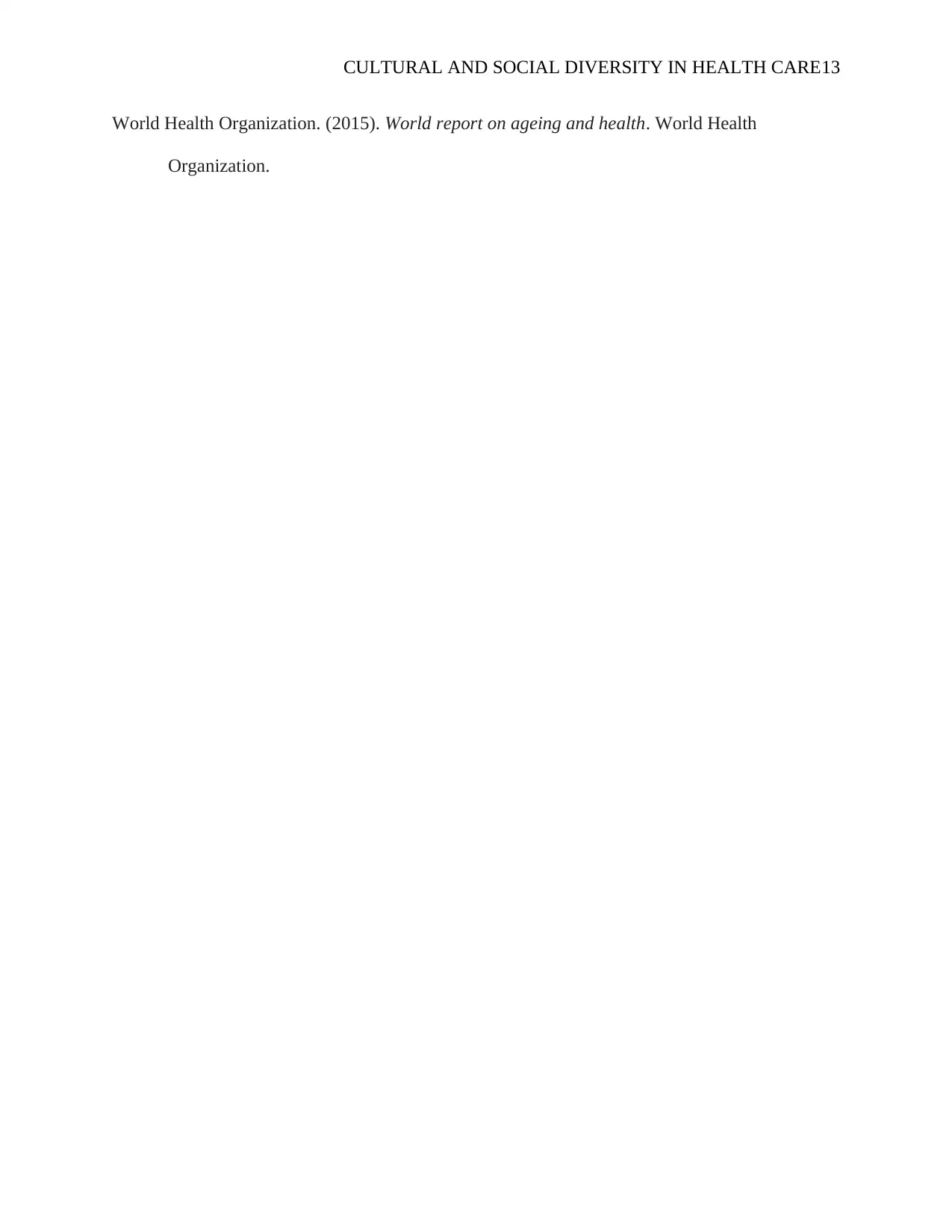
CULTURAL AND SOCIAL DIVERSITY IN HEALTH CARE13
World Health Organization. (2015). World report on ageing and health. World Health
Organization.
World Health Organization. (2015). World report on ageing and health. World Health
Organization.
1 out of 13
Related Documents
Your All-in-One AI-Powered Toolkit for Academic Success.
+13062052269
info@desklib.com
Available 24*7 on WhatsApp / Email
![[object Object]](/_next/static/media/star-bottom.7253800d.svg)
Unlock your academic potential
© 2024 | Zucol Services PVT LTD | All rights reserved.





